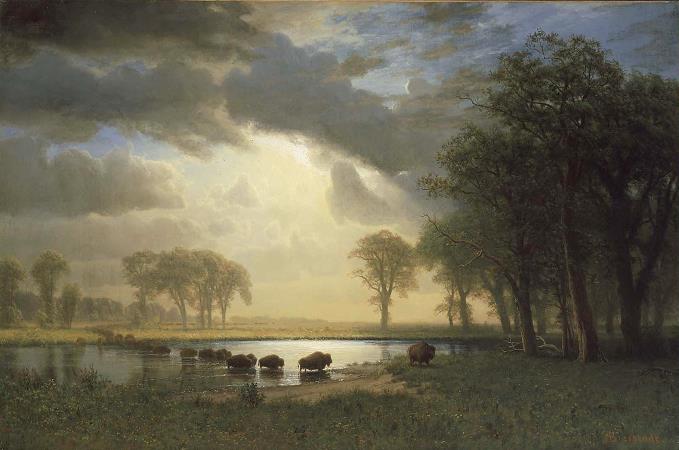Buffalo. The American bison, commonly known as the buffalo, is a species of bison that is endemic to North America. It is a powerful symbol of the American West and has been depicted in various forms of art. Early Native American rock art and petroglyphs often feature the buffalo, highlighting its importance in culture and human survival. Later, European American artists, such as George Catlin and Charles M. Russell, depicted the buffalo in realistic paintings, capturing its physical attributes and its role in the lives of Native American peoples. More contemporary artists have used the buffalo as a symbol of both the past and the present, exploring themes of environmentalism, cultural identity, and the impact of westward expansion. It is one of two extant species of bison, along with the European bison. Its historical range circa 9000 BC is referred to as the great bison belt, a tract of rich grassland spanning from Alaska south to the Gulf of Mexico, and east to the Atlantic Seaboard, as far north as New York, south to Georgia, and according to some sources, further south to northern Florida, with sightings in North Carolina near Buffalo Ford on the Catawba River as late as 1750. Two subspecies or ecotypes have been described: the plains bison, smaller and with a more rounded hump; and the wood bison, the larger of the two and having a taller, square hump. Furthermore, the plains bison has been suggested to consist of a northern plains and a southern plains subspecies, bringing the total to three. However, this is generally not supported. The wood bison is one of the largest wild species of extant bovid in the world, surpassed only by the Asian gaur. Among extant land animals in North America, the bison is the heaviest and the longest, and the second tallest after the moose. Once roaming in vast herds, the species nearly became extinct by a combination of commercial hunting and slaughter in the 19th century and introduction of bovine diseases from domestic cattle. With an estimated population of 60 million in the late 18th century, the species was reduced to just 541 animals by 1889 as part of the subjugation of the Native Americans, because the American bison was a major resource for their traditional way of life. Recovery efforts expanded in the mid-20th century, with a resurgence to roughly 31,000 wild bison as of March 2019. For many years, the population was primarily found in a few national parks and reserves. Through multiple reintroductions, the species now freely roams freely in several regions in the United States, Canada and Mexico. The American bison has also been introduced to Yakutia in Russia. Spanning back millennia, Native American tribes have had cultural and spiritual connections to the American bison. It is the national mammal of the United States.
more...














